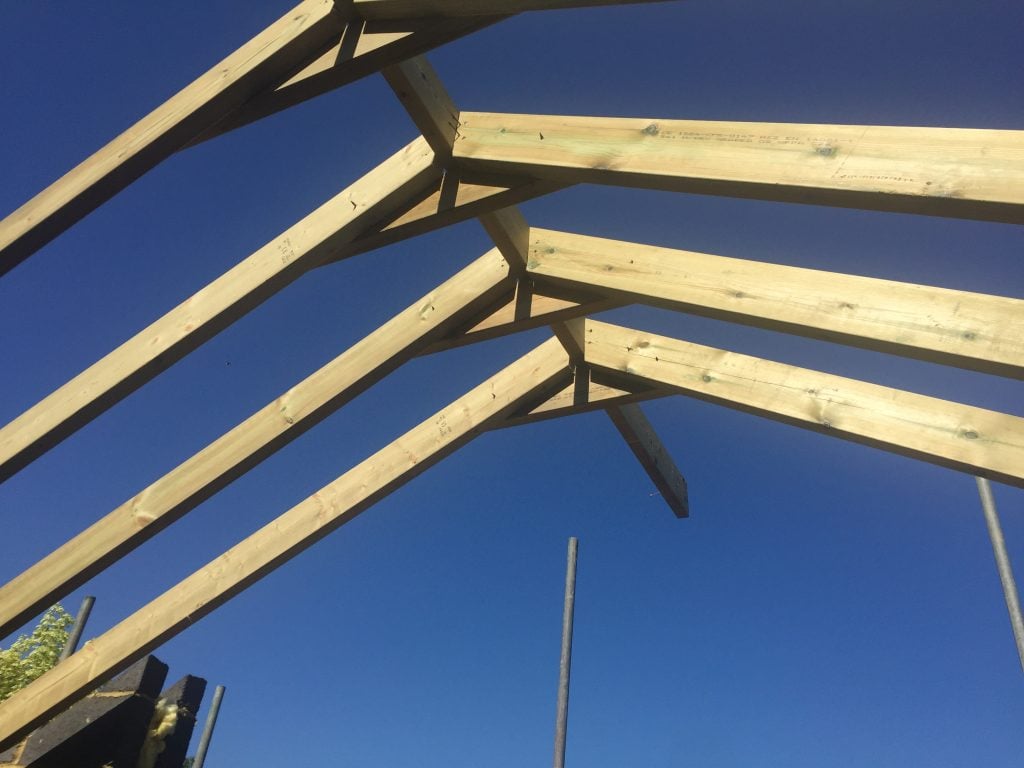
Loft Conversion
A loft conversion is completely separate from any other extension type. Best results are from Permitted Development.
You can achieve almost full width and depth, but no higher than the existing roof. The best roof type for the loft extension is a gabled roof (2 sides slope) rather than a hipped roof (all 4 sides slope).
Always remember, you may lose a bit of space on the floor below when installing the staircase. Loft conversions are great for creating an extra bedroom, maybe with an ensuite.

What factors affect the cost of a loft conversion?
- The type of roof structure you have
- Loft size
- Conversion complexity
What type of roof structures are there?
- Trussed Roof
A trussed roof is a more modern way of making a roof. It uses smaller timbers manufactured into a truss (structural component). If you have this you will have to cut out the timber members that will be in the room. - Traditional Cut Roof
A traditional cut roof is the typical roof that gets Loft Conversion. It has a more open loft space with rafters.
Other Cost Factors
- Reinforcement of the floor
- Insulation as the loft will now be a habitable room
- Electrics and heating
- Large windows/skylights with blinds and automated controls
- Adding a staircase
- Do you need to move the water tank?
- Are you having an ensuite installed? This will add further complexity of plumbing
- Do you want air conditioning installed? This is also becoming more popular these days, with typical costs of £2,000-£3,000 for a loft conversion.
The best roof type for the loft extension is a gabled roof (2 sides slope) rather than a hipped roof (all 4 sides slope). Always remember, you may lose a bit of space on the floor below when installing the staircase.
- Yoop Architects TWEET THIS
What types of loft conversion are there & how much do they cost?
Room Loft Conversion
A room loft conversion is where you board out the loft and add a staircase. Maybe add a few skylight windows in the slope of the roof. You would require a good sized loft with good head height.
Prices start from £15,000
Dormer Loft Extension
A dormer loft extension is where a big box is typically added to the rear of the roof. This gives lots more space. Typically created via permitted development.
Prices start from £20,000 or from £35,000 with the inclusion of an en suite
‘Raising the Roof’ or Changing the Roof Structure
If the head height is not enough, altering the roof can be achieved via planning permission but can be difficult. The planners may suggest it will be incongruous to the original house as it may look different to the adjacent housing. Where it maybe possible is when houses are on a sloping street and ridge heights are not related to each other. Can be costly as it required a new roof.
Prices start from £40,000
Hip to Gable Roof Extension
A hipped roof is when all four sides of the roof slope in towards the middle. The loft space is not very good. A gabled roof is like a roof of a terraced house – two sides of the roof slope and the other two sides have a wall which go all the way up to the ridge (top of the roof). The gable roof is good for loft conversion extensions.
There is a permitted development where you can do a hip to gable extension – usually on a semi detached property. Councils do not like this type of development as it will unbalance a semi detached pair but if done correctly at permitted development, the council can not stop it.
Prices start from £25,000
Inside this easy to read free guide, discover the things you need to consider before converting your loft.
Do I need building regulations for a loft conversion?
All extension work requires building regulations approval and you may need building regulations approval for many alteration projects.
However, you do not need to get approval yourself if you use someone registered with a competent person scheme.
Do I need insurance for a loft conversion?
If you are carrying out loft conversion/extension works you should arrange specialist insurance to cover the new works and the existing structure as most home insurers won’t cover works if contracts exceed £50,000.
It is important to sort insurance in good time as most insurers will not insure when works have already started. GPS Insurance Brokers can provide specialist insurance cover for conversion/extension works and the insurance will last for the duration of the building project. Insurance should be arranged as soon as you know works will commence.
You should also inform your home insurer as an extra room could result in a higher buildings insurance premium. Failing to inform your insurer of any changes to your property could invalidate your home insurance policy for loft conversion.
For expert advise on this and any other insurance exposures, please contact Gary Philip at GPS Insurance Brokers on 020 8207 7385. GPS Insurance
FREE EXPERT HELP TODAY
Thinking of your dream home improvement or how to start your project?
Need your planning questions answered? Talk to an expert today.
Book a FREE 20 Minute Call with one of our home improvement Architects.


